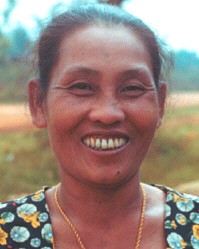Lao Ga in Thailand

Photo Source:
Copyrighted © 2025
Peoples of the Buddhist World, Asia Harvest All rights reserved. Used with permission |
Send Joshua Project a map of this people group.
|
| People Name: | Lao Ga |
| Country: | Thailand |
| 10/40 Window: | Yes |
| Population: | 2,100 |
| World Population: | 2,100 |
| Primary Language: | Language unknown |
| Primary Religion: | Buddhism |
| Christian Adherents: | 0.80 % |
| Evangelicals: | 0.50 % |
| Scripture: | Unspecified |
| Ministry Resources: | No |
| Jesus Film: | No |
| Audio Recordings: | No |
| People Cluster: | Lao |
| Affinity Bloc: | Southeast Asian Peoples |
| Progress Level: |
|
Introduction / History
The closely-related Lao Krang people were also captured as prisoners of war at the same time, but their homeland was near Luang Prabang in Laos rather than Vientiane. Therefore, despite their similar history and origins, the two groups consider themselves separate and have no contact with each other, even though both live in Uthai Thani Province. In fact, it could be said the Lao Ga have more in common with the Lao Wieng, who also originated in Vientiane but today speak a different dialect.
The Lao Ga speak a language closely related to the Isan language of north-east Thailand. Consequently, most ethnolinguistic studies of Thailand do not mention them at all. One report claims that the Lao Ga "speak a dialect quite similar to the Lao Krang but distinguish themselves from the Lao Krang primarily by their loud and croaking voice. This is why other Lao groups call them Ga or Gao, meaning crow. The designation Ga or Gao is offending for these people. The Lao Ga consider themselves a distinct Lao speaking group."
Members of this small group are the descendants of prisoners of war. In the 1800s the Siamese army captured many people during their conquest of Vientiane (the present-day capital of Laos). They forced their captives to march vast distances across Thailand, where they eventually settled down in remote areas. Over time the people formed a distinct community with their own customs, dialect and common identity as Lao Ga people.
They inhabit one main village, Ban Tabluang, in the Ban Rai District of Uthai Thani Province.
What Are Their Lives Like?
The main occupation of Lao Ga women is spinning, weaving and dyeing. They are skilled producers of blankets, tablecloths and pillows which they make on traditional spinning wheels and weaving looms. The income they earn from these and other economic enterprises makes the Lao Ga comparatively well off. The men are able to use tractors to cultivate their fields instead of water buffaloes and oxen. The main crops of the Lao Ga are rice, maize, tobacco and sugarcane. The men also use bamboo traps to catch grasshoppers, field rats and red ant eggs, all of which are considered highly-prized delicacies.
Despite their small numbers, the Lao Ga try to intermarry within their own tribe. For many youngsters, however, this is impossible because of the lack of choices, so in recent years the Lao Ga have started to intermarry with the Thai, Lao Wieng, Lao Isan, and Chinese. The groom's family is required to pay a price to the family of the bride before the wedding can take place.
What Are Their Beliefs?
One hundred per cent of Lao Ga people are Buddhists. Christianity has yet to make any impact on this people group.
What Are Their Needs?
These people need to realize that they cannot please God without being empowered by the Holy Spirit. They cannot have the Holy Spirit without Jesus Christ.
Prayer Points
Pray for a movement of Jesus to heal and strengthen Lao Ga communities.
Pray for a "Book of Acts" type of movement to Christ among the Lao Ga people in Thailand.
Pray for the Lao Ga people to understand and embrace that Jesus wants to bless their families and neighborhoods.
Pray for Holy Spirit anointed believers from the Lao Ga people to change their society from within.
Pray for a movement in which the Holy Spirit leads and empowers disciples to make more disciples.